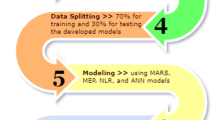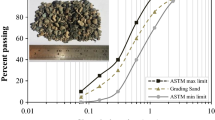Abstract
Soft computing techniques, i.e., linear regression, artificial neural network, genetic expression programming, etc., are being practiced for the prediction of data. In this study, artificial neural network model predicted the consistency, setting time, and compressive strength of mortar at various curing time. The eighteen distinct mix proportions of cement mortar consisting of accelerators, i.e., calcium nitrate and triethanolamine as additives and stone powder as replacement of cement were selected for the prediction of various parameters. The accelerators are used to fasten the stiffening of cementitious materials and speed up the construction work. Stone powder was used to minimize the consumption of cement and problems associated with waste to the ecosystem. The laboratory data set was used for the prediction model. The appropriate artificial neural network model constitutes mix constituents as input parameters, i.e., cement, sand, water, and additional materials. The results from ANN training in multilayer feedforward neural network were evaluated and compared with the experimental results. A graphical representation between predicted and experimental results was also drawn. Results showed that artificial neural network technique was found effective for the prediction of various parameters of cement mortar with high correlation coefficients and low values of mean absolute error and root mean squared error.
Access this chapter
Tax calculation will be finalised at checkout
Purchases are for personal use only
Similar content being viewed by others
References
Devi K, Saini B, Aggarwal P (2018) Effect of accelerators with waste material on the properties of cement paste and mortar. Comput Concr 22:153–159
Devi K, Saini B, Aggarwal P (2018) Combined use of accelerators and stone slurry powder in cement mortar. Springer Nature Switzerland AG 2019, vol 21, pp 1–8
Khodabakhshian A, de Brito J, Ghalehnovi M, Shamsabadi EA (2018) Mechanical, environmental and economic performance of structural concrete containing silica fume and marble industry waste powder. Constr Build Mater 169:237–251
Rana A, Kalla P, Csetenyi LJ (2015) Sustainable use of marble slurry in concrete. J Clean Prod 94:304–311
Devi K, Acharya KG, Saini B (2018) Significance of stone slurry powder in normal and high strength concrete. Springer Nature Switzerland AG 2019, vol 21, pp 484–492
Singh H, Garg P, Kaur I (eds) (2018) In: Proceeding of 1st international conference on sustainable waste management through design. Springer Nature America
Naderpour H, Nagai K, Fakharian P, Haji M (2019) Innovative models for prediction of compressive strength of FRP-confined circular reinforced concrete columns using soft computing methods. Compos Struct 215:69–84
Eskandari H, Tayyebinia M (2016) Effect of 32.5 and 42.5 cement grades on ANN prediction of fibrocement compressive strength. Proc Eng 150:2193–2201
Khashman A, Akpinar P (2017) Non-destructive prediction of concrete compressive strength using neural networks. Proc Comput Sci 108:2358–2362
Diab AM, Elyamany HE, Elmoaty MAEA, Shalan AH (2014) Prediction of concrete compressive strength due to long term sulfate attack using neural network. Alexandria Eng J 53:627–642
Prasad BKR, Eskandari H, Reddy BVV (2009) Prediction of compressive strength of SCC and HPC with high volume fly ash using ANN. Constr Build Mater 23:117–128
Lee S (2003) Prediction of concrete strength using artificial neural networks. Eng Struct 25:849–857
Demir F (2008) Prediction of elastic modulus of normal and high strength concrete by artificial neural networks. Constr Build Mater 22:1428–1435
Uysal M, Tanyildizi H (2011) Predicting the core compressive strength of self-compacting concrete (SCC) mixtures with mineral additives using artificial neural network. Constr Build Mater 25:4105–4111
Chou J-S, Tsai C-F (2012) Concrete compressive strength analysis using a combined classification and regression technique. Autom Constr 24:52–60
Chithra S, Kumar SRRS, Chinnaraju K, Ashmita FA (2016) A comparative study on the compressive strength prediction models for high performance concrete containing nano silica and copper slag using regression analysis and artificial neural networks. Constr Build Mater 114:528–535
Eskandari H, Nik MG, Eidi MM (2016) Prediction of mortar compressive strengths for different cement grades in the vicinity of sodium chloride using ANN. Proc Eng 150:2185–2192
Azimi-Pour M, Eskandari-Naddaf H (2018) ANN and GEP prediction for simultaneous effect of nano and micro silica on the compressive and flexural strength of cement mortar. Constr Build Mater 189:978–992
Onyari EK, Ikotun BD (2018) Prediction of compressive and flexural strengths of a modified zeolite additive mortar using artificial neural network. Constr Build Mater 187:1232–1241
Mahdinia S, Eskandari-Naddaf H, Shadnia R (2019) Effect of cement strength class on the prediction of compressive strength of cement mortar using GEP method. Constr Build Mater 198:27–41
Naderpour H, Rafiean AH, Fakharian P (2018) Compressive strength prediction of environmentally friendly concrete using artificial neural networks. J Build Eng 16:213–219
Author information
Authors and Affiliations
Corresponding author
Editor information
Editors and Affiliations
Rights and permissions
Copyright information
© 2021 Springer Nature Singapore Pte Ltd.
About this paper
Cite this paper
Devi, K., Saini, B., Aggarwal, P. (2021). Prediction of Setting Time and Strength of Mortar Using Soft Computing Technique. In: Shukla, S.K., Chandrasekaran, S., Das, B.B., Kolathayar, S. (eds) Smart Technologies for Sustainable Development. Lecture Notes in Civil Engineering, vol 78. Springer, Singapore. https://doi.org/10.1007/978-981-15-5001-0_9
Download citation
DOI: https://doi.org/10.1007/978-981-15-5001-0_9
Published:
Publisher Name: Springer, Singapore
Print ISBN: 978-981-15-5000-3
Online ISBN: 978-981-15-5001-0
eBook Packages: EngineeringEngineering (R0)




